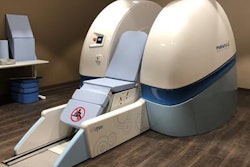Thursday, December 5 | 11:50 a.m.-12:00 p.m. | SSQ03-09 | Room E450B
The combination of coronary CT angiography (CCTA) and 4D flow MRI identified substantially larger areas of abnormal wall shear stress in venous grafts, which were associated with a higher failure rate than arterial grafts, in a study by researchers from Canada."Graft failure is a major complication in coronary artery bypass graft (CABG) surgery, whose root causes are still unknown," presenter Dr. Laura Jimenez-Juan from the University of Toronto told AuntMinnie.com. "In coronary arteries, growing evidence indicates that low and oscillatory values of wall shear stress contribute to atherosclerosis plaque progression, but the role of WSS in graft failure still remains unclear."
Seeking to better understand graft failure, Jimenez-Juan and colleagues developed a computational fluid dynamics model that enabled them to obtain wall shear stress measurements of the arterial and venous grafts noninvasively from 4D flow MRI and CCTA scans. They applied their model to the imaging data of five patients who underwent 4D flow MRI and CCTA following coronary artery bypass graft surgery.
The researchers found much larger areas of abnormal wall shear stress in the venous grafts than in the arterial grafts (p = 0.022). This difference could be indicative of graft failure, as venous grafts with abnormal wall shear stress measurements were associated with a higher failure rate.
"Our work is a step forward toward understanding the root causes of graft failure in CABG patients and identifying reliable biomarkers for the early prediction of graft failure," Jimenez-Juan said.



.fFmgij6Hin.png?auto=compress%2Cformat&fit=crop&h=100&q=70&w=100)




.fFmgij6Hin.png?auto=compress%2Cformat&fit=crop&h=167&q=70&w=250)











